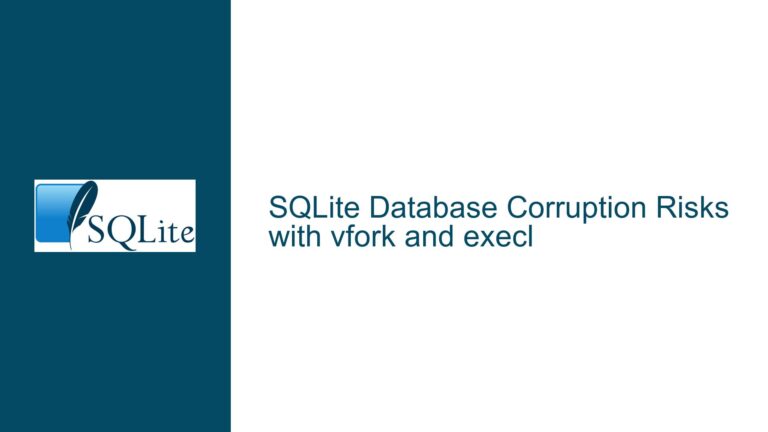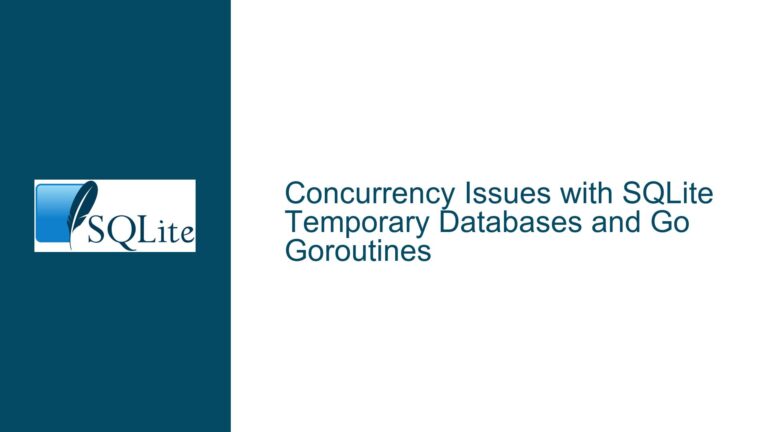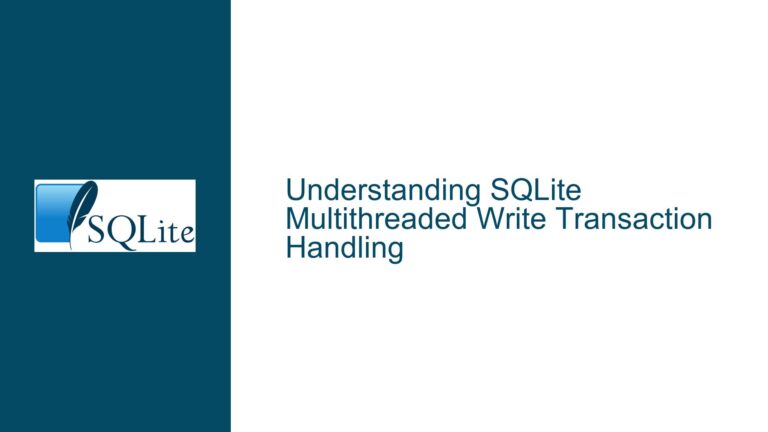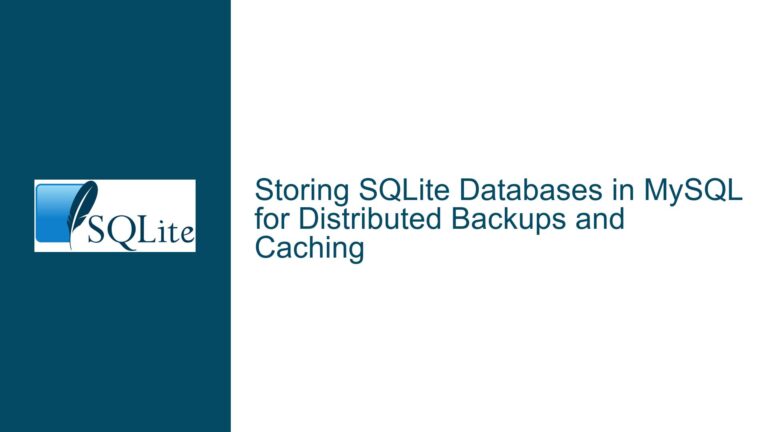Improving Concurrency in SQLite for Multi-User Applications
Understanding SQLite’s Concurrency Limitations and the Need for Table-Level Locking
SQLite is a lightweight, serverless database engine that is widely used in applications where simplicity, portability, and low resource consumption are critical. However, its concurrency model is often misunderstood, especially in multi-user environments where multiple connections attempt to read and write to the same database simultaneously. The core issue revolves around SQLite’s design, which allows only one write transaction to be active at any given time. This design choice ensures data integrity but can lead to performance bottlenecks in scenarios where multiple users or processes need concurrent write access to different tables.
The discussion highlights a scenario where a small workgroup accesses a shared SQLite database over a fast LAN. Each user runs a separate instance of the application, and the goal is to improve concurrency without introducing excessive complexity. The proposed solution involves using SAVEPOINT statements with a CONSTRAINT clause to confine transactions to specific tables, thereby reducing contention. However, this approach conflicts with SQLite’s fundamental design principles, as it inherently supports only one active write transaction per database file.
Why SQLite’s Single-Writer Model Hinders Table-Level Concurrency
SQLite’s concurrency model is built around a single-writer, multiple-reader (SWMR) architecture. This means that while multiple connections can read from the database simultaneously, only one connection can perform write operations at any given time. Write transactions in SQLite are serialized, and any attempt to initiate a second write transaction while one is already active will result in an SQLITE_BUSY error. This behavior is deeply ingrained in SQLite’s design and cannot be circumvented without modifying the database engine itself.
The idea of using a CONSTRAINT clause with SAVEPOINT to enforce table-level locking is theoretically appealing but fundamentally incompatible with SQLite’s architecture. SQLite does not maintain a global shared structure for tracking table-level locks, nor does it support fine-grained locking at the table level. The SAVEPOINT mechanism is designed to create nested transactions within a single connection, allowing partial rollbacks without affecting the entire transaction. However, it does not provide any concurrency control between different connections.
Furthermore, the suggestion to use a global shared structure to track table-level locks would require significant changes to SQLite’s core functionality. SQLite operates as a library, not as a client-server database, and it lacks the infrastructure to manage shared state across multiple connections. Even if such a mechanism were implemented, it would introduce additional complexity and overhead, potentially negating the performance benefits of improved concurrency.
Strategies for Improving Concurrency in SQLite Applications
Given SQLite’s inherent limitations, improving concurrency in multi-user applications requires a combination of best practices and creative workarounds. Below are some strategies that can help mitigate contention and enhance performance in such scenarios.
1. Minimizing Transaction Duration
One of the most effective ways to reduce contention in SQLite is to keep transactions as short as possible. Long-running transactions, especially those involving write operations, can block other connections and lead to SQLITE_BUSY errors. Applications should aim to perform all necessary read and write operations within the shortest possible transaction scope. For example, instead of holding a transaction open while waiting for user input, the application should gather all required data first and then execute the transaction in a single, quick operation.
In the context of the discussed scenario, where users interact with forms over a remote display, the application should avoid initiating transactions until all form data is ready to be committed. This approach minimizes the time during which the database is locked, allowing other users to perform their operations without unnecessary delays.
2. Leveraging In-Memory Databases for Temporary Data
Another strategy to improve concurrency is to use in-memory databases for temporary data storage. SQLite supports the creation of in-memory databases, which are not subject to the same concurrency constraints as file-based databases. Applications can use in-memory databases to store intermediate results or form data, reducing the frequency of write operations on the main database.
For instance, in the discussed scenario, each user’s application could create an in-memory database to store form data as it is being entered. Once the form is complete, the data can be transferred to the main database in a single transaction. This approach not only reduces contention but also improves performance by minimizing disk I/O.
To implement this strategy, the application can use the ATTACH DATABASE statement to associate an in-memory database with the current connection. Data can then be copied from the in-memory database to the main database using INSERT INTO ... SELECT statements. Care must be taken to handle errors and ensure data consistency during the transfer process.
3. Implementing Application-Level Concurrency Control
Since SQLite does not support table-level locking or fine-grained concurrency control, applications must implement their own mechanisms to manage concurrent access to shared data. This can be achieved through application-level locking or versioning schemes.
For example, the application could maintain a separate table to track locks or versions for each row or table. Before performing a write operation, the application would check the lock or version information to ensure that no other user has modified the data since it was last read. If a conflict is detected, the application can notify the user and provide options for resolving the conflict.
In the discussed scenario, the application already employs basic mechanisms to prevent concurrent writes to the same row and report changes at the GUI level. These mechanisms can be extended to handle more complex scenarios, such as multi-row or multi-table transactions. However, care must be taken to ensure that the overhead of application-level concurrency control does not outweigh its benefits.
4. Using WAL Mode for Improved Read Concurrency
SQLite’s Write-Ahead Logging (WAL) mode can significantly improve read concurrency in multi-user environments. In WAL mode, readers do not block writers, and writers do not block readers. This allows multiple connections to read from the database simultaneously, even while a write transaction is in progress.
To enable WAL mode, the application can execute the following SQL statement:
PRAGMA journal_mode=WAL;
Once WAL mode is enabled, the database will use a write-ahead log file (<database>-wal) to record changes, allowing readers to access the database without waiting for write transactions to complete. However, it is important to note that WAL mode does not eliminate the single-writer constraint. Only one write transaction can be active at any given time, and concurrent write transactions will still result in SQLITE_BUSY errors.
5. Partitioning Data Across Multiple Databases
In some cases, it may be possible to partition data across multiple SQLite databases to reduce contention. For example, if the application manages data for multiple users or departments, each user or department could have their own database file. This approach allows each user to perform write operations on their own database without affecting others.
However, data partitioning introduces additional complexity, as the application must manage multiple database connections and handle cross-database queries. It may also require changes to the application’s data model and query logic. Therefore, this strategy should be used only when the benefits of reduced contention outweigh the added complexity.
6. Monitoring and Optimizing Database Performance
Finally, applications should monitor and optimize database performance to identify and address potential bottlenecks. SQLite provides several tools and pragmas for monitoring database activity and performance, including:
PRAGMA busy_timeout: Sets a timeout forSQLITE_BUSYerrors, allowing the application to wait for a specified period before retrying a transaction.PRAGMA cache_size: Adjusts the size of the database cache to improve performance.PRAGMA synchronous: Controls the level of synchronization between the database and the disk, allowing for a trade-off between performance and data integrity.
By carefully tuning these parameters and monitoring database activity, applications can identify and resolve performance issues before they impact users.
Conclusion
Improving concurrency in SQLite for multi-user applications requires a deep understanding of the database’s limitations and a combination of best practices and creative solutions. While SQLite’s single-writer model poses challenges, strategies such as minimizing transaction duration, leveraging in-memory databases, implementing application-level concurrency control, using WAL mode, partitioning data, and optimizing performance can help mitigate contention and enhance performance. By carefully designing and implementing these strategies, developers can create robust and efficient multi-user applications that leverage SQLite’s strengths while addressing its limitations.






